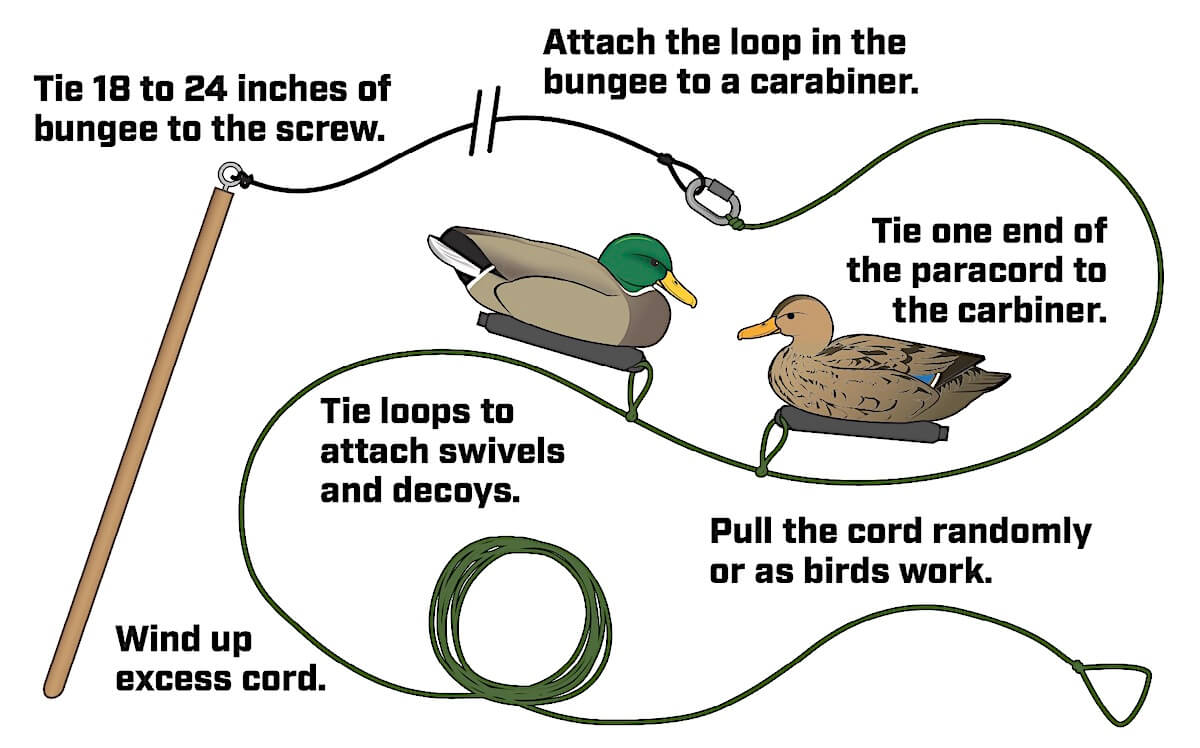
On calm days, floaters rarely produce enough motion. Place jerk-cord decoys where they add the most movement to the spread. (Shuitterstock image)
If you’ve hunted ducks for any significant amount of time, you’ve no doubt encountered this scenario. You have set out 2- to 3-dozen mallard decoys on a perfect little out-of-the-way pothole, but there’s not a whisper of wind. Your setup—arduously scouted and carefully crafted—unfortunately looks exactly like what it is: 30 plastic ducks sitting on the surface of a mirror.
The quickest fix for these frozen-in-time decoy spreads is the addition of a jerk cord, which is little more than a length of stout cord anchored in the spread and stretching back to the blind, with a few lightweight decoys attached to it. With a yank on the cord, the decoys bounce, creating ripples and waves and the illusion of on-the-water motion made by living, breathing ducks. Commercially crafted jerk cords are, of course, available. But it’s also easy and inexpensive to create your own—and quite satisfying when the stars align and you fool birds with your handiwork. Here’s the DIY approach to get it done.

MATERIALS LIST
- Old broom handle or 1-inch-by-1-inch pole of 2 to 6 feet (depending you your typical water depth).
- Circle-eye screw (1/4 inch by 3 inches)
- Small stainless carabiner clip (1 1/2 inches)
- Two large snap swivels
- 18 to 24 inches of 1/4-inch bungee or shock cord
- 100 feet of 550 paracord in brown, green or black
- Cordless drill with 1/8-inch bit
Note: The majority of my non-tidal waterfowling takes place on water less than 24 inches deep, so my DIY cord handles are often 48 inches long. It’s simple, however, to adjust the length/height of the handle to your own hunting situations.
INSTRUCTIONS
- Drill a 1/8-inch pilot hole in one end of the broom handle or pole and insert the circle-eye screw.
- Using the improved clinch knot, attach one end of the bungee to the screw eye. Make a small loop in the opposite end of the bungee. A single overhand knot works well here. Attach the carabiner to the loop.
- Again, using the improved clinch knot, tie one end of the paracord to the carabiner. At 16 inches and 20 inches from the carabiner, attach the large snap swivels to the paracord with simple loop-style ties (see illustration).

USING IT
Once on the water, I decide where to set my spread, then build it around the jerk cord, which is positioned first. I do make a point of placing my jerk cord decoys close enough to some of my anchored decoys so the jerk rig imparts motion via ripples and waves to as much of the spread as possible. Don’t worry about creating too much motion. As long as the motion is natural or realistic, it’s virtually impossible to have too much of it.
To begin, I push the broom handle or pole into the bottom with the screw eye as close to the surface as possible. If the water I’m hunting is shallower than my stake is long, I’ll angle the pole into the water.
Next, I clip the carabiner to the loop on the bungee, then clip an ultra-lightweight water keel green-winged teal decoy to each of the large snap swivels. Finally, I pay out enough 550 paracord to comfortably reach the blind location, toss out my floaters and settle in for the hunt.
When do I put the jerk cord into action? Occasionally, I’ll operate the rig randomly—that is, when I’m not actually working birds that I can see. Flying ducks can see the ripples a jerk rig generates at a great distance. It attracts them much in the same way that waves made when a hunter’s mucking around in the spread do. More often, though, I’ll run the cord in conjunction with a call when a bird or birds are actively working the spread. However, I’m also very careful to conceal the movement I make when I’m operating the jerk cord.
ANCHOR OPTION
An alternative to the broom handle—one that doesn’t limit the water depth hunted to the length of the handle—is to use a 1- or 1 1/2-pound folding grapnel anchor like you might use with a canoe or kayak. The step-by-step instructions remain otherwise the same. A short section of bungee/shock cord is tied to the anchor, followed by the carabiner and 550 cord to the blind. If you want to get fancy, a paracord winder ($3 to $5; paracordplanet.com), along with a small drawstring mesh bag, make quick work of deploying, retrieving and stowing the jerk rig.







































![Air gun 101: The differences between .177 & .22 – Which jobs they do best ? [Infographic]](https://airgunmaniac.com/wp-content/uploads/2020/09/g44-150x150.jpg)



